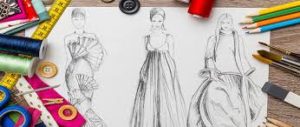 Fashion design courses are primarily offered at art schools and universities through certificate and associate’s, bachelor’s or master’s degree programs in fashion design, merchandising and other related fields. Due to the nature of fashion design, enrolled students are typically required to complete a number of hands-on projects dealing with the start-to-finish process of garment creation. Fashion design students are also commonly required to create an original portfolio that showcases their work. Some courses may also give students the chance to gain additional fashion design skills by participating in runway shows.
Fashion design courses are primarily offered at art schools and universities through certificate and associate’s, bachelor’s or master’s degree programs in fashion design, merchandising and other related fields. Due to the nature of fashion design, enrolled students are typically required to complete a number of hands-on projects dealing with the start-to-finish process of garment creation. Fashion design students are also commonly required to create an original portfolio that showcases their work. Some courses may also give students the chance to gain additional fashion design skills by participating in runway shows.
Here is an outline of common concepts taught in fashion design courses:
- Creative design
- Pattern drafting
- Fashion illustration
- Fashion and art
- Fitting
List of Courses
Construction Basics Course
A construction basics course is typically offered as an introduction to how clothing is assembled. Students learn how cut, fabric, seams and other aspects of construction come together to create a piece of clothing. Students can gain hands-on experience in altering patterns and study how slight alterations in patterns can produce unique garments.
Textiles Course
The textiles course is usually taken early in a fashion design program as an introduction to the different fabrics and other textiles used in the creation of fashion items. Students learn about the difference in natural and man-made fabrics, as well as how fabric is manufactured. The course also teaches students about other textiles, such as wool, silk or cotton.
Patternmaking Course
The patternmaking course is usually a first-year course that provides a firm foundation in making patterns used in creating clothing. Students learn how to create master patterns that can be used to make a wide variety of garments and, in some programs, sew clothing from the patterns they have created.
Tailoring Course
Tailoring is the process of fitting a garment so that it drapes properly. In this course, which builds on introductory fashion design coursework, students learn how patterns influence fit and how they can be adjusted. Industry standards and use of industrial sewing machines may be emphasized in some programs.
Computer Assisted Drawing (CAD) Course
The computer assisted drawing (CAD) course focuses on the computer programs commonly used in the fashion design industry, as well as how to use CAD to create patterns, fabrics and other designs. Students learn about technical design specifications, terminology and the basics of using CAD. This course is usually offered in the second year of a program.
Portfolio Development Course
Fashion designers must have portfolios that show off their work, skills and abilities. Creating a portfolio involves knowing how to design and put together a collection, as well as staging photographs. Students may also work with runway productions and learn about fitting models, choosing show music and other aspects of creating a fashion show. At the end of the course, students may create a final portfolio or produce a runway show.
Fashion design courses cover the gamut of basic construction of clothing, textiles, patternmaking, tailoring, computer assisted drawing and portfolio development so that prospective designers have a fighting chance in a competitive world.





